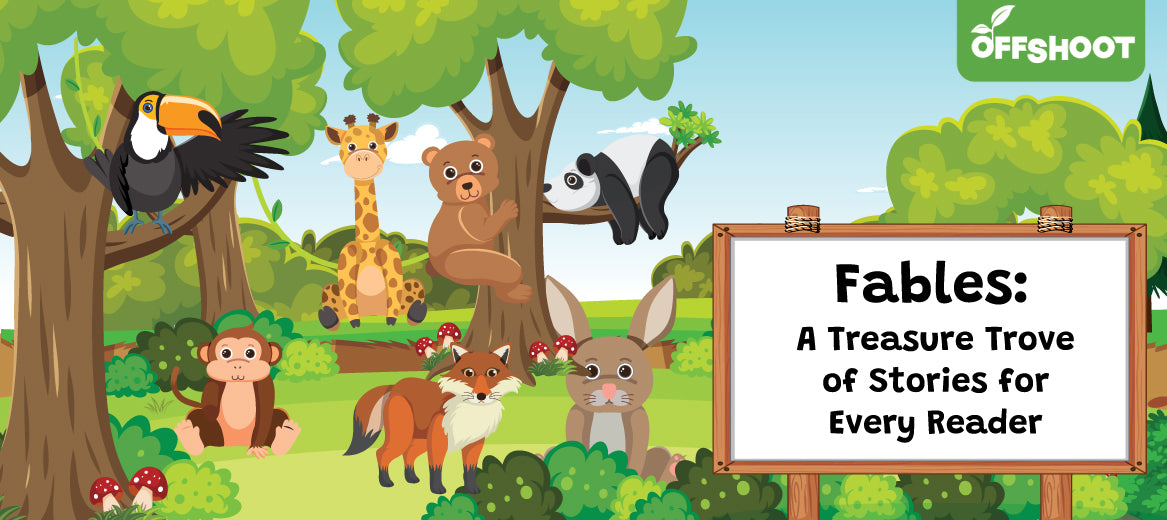
Fables: A Treasure Trove of Stories for Every Reader
| Offshoot Books
Are you looking for some good reads to immerse in during your spare time? Or are you a new member in the bookworms’ club? Well, we welcome you irrespective of your relationship status with books, for we have something for everyone. We have good-read-ies waiting for you as you have walked into our blog.
So, let’s start with a pro tip about, well, ‘starting’- always start (your reading journey) easy. Start with what is familiar and relatable. Remember, small steps prove to be the most important ones in any journey. Did we just sound like a fable? Well, that was intended.
We are going to tell you about Aesop’s fables and Panchatantra today. Both these groups of stories are enriched with fables. They are widely loved for their moral values and quality of being entertaining for kids.
Let’s start the discussion with Aesop’s Fables. Read on…
What are Aesop's fables?
Written by Aesop in the late to mid-6th century BCE, Aesop's fables are renowned as the most loved and cherished collection of moral tales throughout the globe. Initially, these narratives were circulated orally. They served not only as entertainment but as mediums for imparting moral wisdom to children. These tales have stories with characters that are animals representing humans in practical scenarios.
Beyond their educational function, Aesop’s fables convey important messages of empowerment, honesty, righteousness and many others. While initially intended as educational tools, Aesop's Fables are also popular as children's entertainment, offering insights into the complexities of adulthood.
Now, knowing that Aesop’s fables are so widely loved, we often wonder what would Aesop say to today's world? Stick with the classic fables or give them a modern spin? Maybe he'd tweak them for Gen Z. And that's what we've done. The stories still teach friendship, honour, kindness, and patience with reference to today's world. With cool art and fun storytelling, these books are a must for every home and library.
These books bring Aesop’s fables into the 21st century and teach kids life skills and moral values without sounding moralising.
Why should you read our retellings of Aesop’s Fables?
Moral lessons with modern takes: Aesop's Fables are known for their simple yet profound moral lessons conveyed through the actions of animals or other characters. Our retellings retain this endearing flavour of the fables and sprinkle newer themes like friendly competition, togetherness, helping out each other and appreciating people for what they are.
Fostering Empathy: Many of Aesop's Fables involve characters experiencing various situations and dilemmas. To complement the adorable character of these stories we have added elements that encourage young readers to break stereotypes.
Encouraging Critical Thinking: Aesop's Fables often include moral dilemmas and twists in the plot, encouraging children to think critically about the consequences of actions and decisions. This helps children to develop problem-solving skills for real life situations.
Promoting Virtues: The fables often promote virtues such as honesty, kindness, perseverance, and courage. By encountering these virtues in storytelling, children are inspired to emulate them in their own lives, leading to positive character development.
So that was about our retellings of fables, but wait a bit. There’s something more in store. And the next one is going to be something that is going to entice you for sure. We are talking about Panchatantra stories.
What is the Panchatantra?
The Panchatantra is a collection of animal fables in both Sanskrit verse and prose, set within a narrative framework. Its origins are traced back to around 200 BCE, although many of the stories likely have much older roots. Traditionally credited to Vishnu Sharma, the text is believed to have origins in ancient times. These fables draw upon ancient oral traditions that have stayed in Indian society for ages.
The tales of the Panchatantra have been passed down in many forms. The most loving places where these fables feature are bedtime stories from grandparents. They have also stayed in popular memory and this is evident in the references people make to them in their day to day activities. But beyond all these, the most important feature of Panchatantra stories is that they can entertain children and teach them moral lessons at the same time. They provide them fun and enjoyable characters and real life scenarios to learn from.
At Offshoot Books, we have a selection of these ancient stories with a fresh and unique art style. The vivid colours and textures make each story come alive, making the books a treasure for collectors. As you flip through the pages, you'll discover a fresh perspective on India. Dive into the world of the lion and the jackal, the mice and the elephants, and other intriguing creatures depicted in both brown and blue hues. Dive into the world of India's forests and animals, while enjoying these timeless classics.
Check out the books here-

Leave a comment
Your email address will not be published.